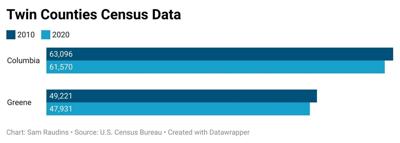Greene County’s population has decreased by more than 1,200 people despite rising home values, a potential labor shortage, increasing sales tax revenue and business growth, according to U.S. Census Bureau data.
In 2010, the county’s population was estimated to be 49,221. The 2020 census tallied 47,931 people, according to the data, for a 2.6% decline. Overall, the state’s population increased 4.2%.
Greene County Administrator Shaun Groden said the county is looking to see how the numbers breakdown, especially by age group.
“I think we’ve got to see the data where that age group is lost from,” Groden said.
According to 2020 Census data, the county’s population under age 18 decreased by 12.4% from 2010 — a loss of 1,176.
Groden said the county is also curious about how people owning second homes in Greene impacted the data.
Despite the population decrease, the state Association of Realtors released data showing that from May 2020 to May 2021, home values in Greene County increased by more than 70%. Greene County Economic Development and Planning Director Karl Heck said in July the spike can be attributed to high demand versus a low supply of homes.
In 2020, Greene County sold a record 903 houses, according to the Association of Realtors. Heck said the U.S. Postal Service reported 800 people moved to the area over the course of the last year.
Groden said 30% of the county’s housing stock is made up of second homes.
The county expressed concern about its labor shortage earlier this year.
Greene County Legislature Chairman Patrick Linger, R-New Baltimore, said the county unemployment rate is low at its current figure of around 5%. Greene County Legislator Michael Bulich, R-Catskill, said the county is losing potential employees.
“The real result is we’ve lost youthful population. You said it before 100 times in other types of job opportunities. Our youth are just not here in the numbers like they were 10 years ago,” Bulich said.
Greene County Chamber of Commerce President Jeff Friedman said a number of different factors contribute to the labor issue. Greene is an older county demographically, with a large segment of the population retired or nearing retirement.
Bulich expressed concern about competing with private-sector wages for labor, as raising wages would only cause private companies to raise theirs.
“There’s a severe shortage of labor,” Greene County Chamber of Commerce President Jeff Friedman said. “Many, many employers are actively searching for help and there are numerous jobs available, far more jobs available even the number of people that are on unemployment.”
In the eight-county Capital Region last year, 9,465 applications to form a business were submitted to the Internal Revenue Service — a 3.2% increase over the previous year. Greene and Schenectady counties led the region in growth, with 17.9% and 19.7% increases, respectively, according to the Center for Economic Growth.
The study examined U.S. Census Bureau data that evaluated how many businesses asked the IRS for an Employer Identification Number, a unique number assigned to businesses for tax reporting. The study defines “businesses” as corporations, partnerships, nonprofits and sole proprietorships.
Friedman said the county has seen a large number of businesses start up in the last few years, spanning many types of industries.
“We’ve had lots of new restaurants, some new manufacturing businesses and new art-related and creative economy businesses. It has been a wide array of businesses across numerous industries,” Friedman said. “So it’s been pretty broad and including in tourism — we’re seeing some new hospitality properties.”
Greene County sales tax collection — which is from the sales of goods and services — from January to May 2021 exceeded $15 million — an increase of more than $3 million over the first five months of 2020, according to a report from the Office of the state Comptroller. Greene County’s sales tax rate is 8%, half of which goes to the state and the other half to the county.









